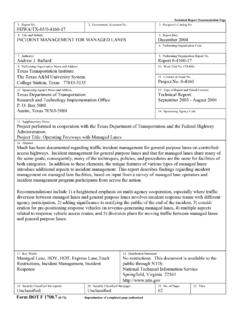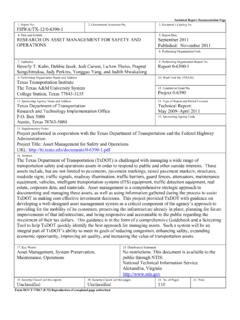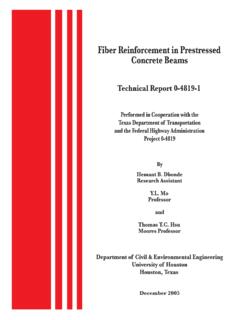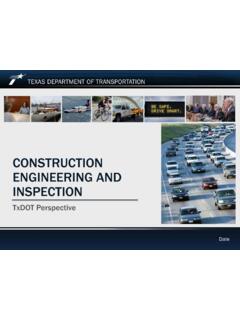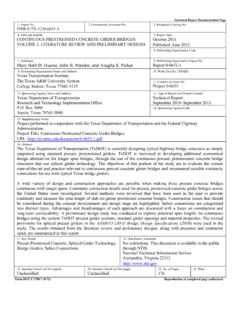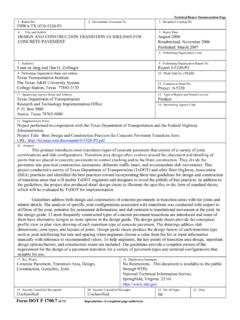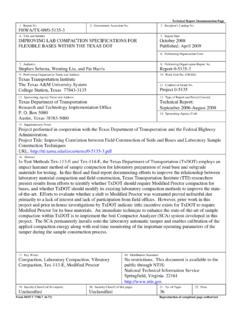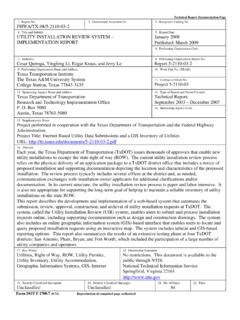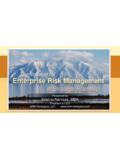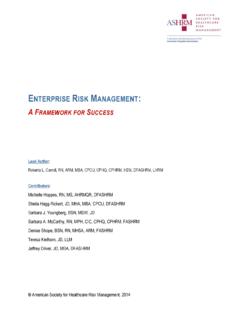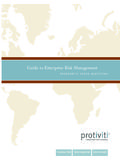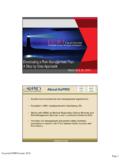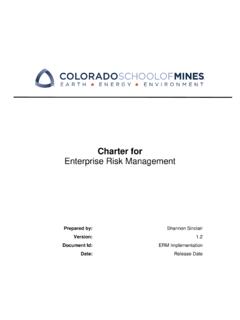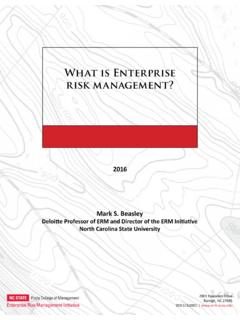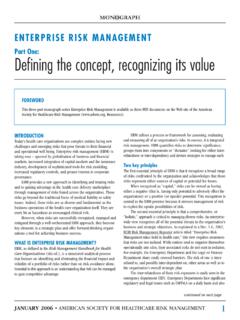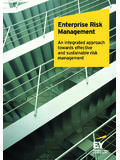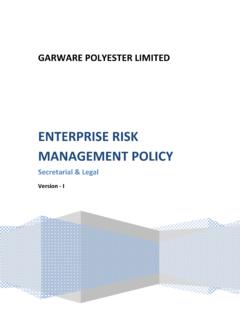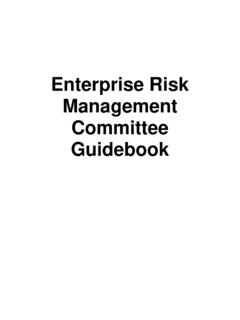Transcription of Enterprise Risk Management Plan FY 2019
1 1 Enterprise Risk Management plan FY 2020 Submitted: April 12, 2019 2 Enterprise Risk Management plan , FY 2019 Introduction Enterprise Risk Management (ERM) at the Texas A&M Transportation Institute (TTI) identifies, monitors and mitigates risks that threaten the achievement of TTI s Strategic plan and/or the continuing operation of the Institute s research program. TTI is committed to the Management of risk in order to protect: the safety and well-being of our employees; our research sponsors and other key stakeholders; the quality of research and service provided by the Institute; our assets, including intellectual property; our contractual and statutory obligations; our image and reputation; and our commitment to The Texas A&M University System, state government and the people of Texas. For each risk the Institute faces, TTI has assessed the likelihood and potential consequences of an adverse event and has prioritized each category of risk according to the level of threat facing the Institute.
2 TTI leadership has determined strategies for managing risks , devoting the greatest resources to the risks considered to present a high-high, high-medium or medium-medium threat. TTI s Risk Register lists these primary risks that impact the Institute. TTI s Risk Matrix lists risk Management strategies to mitigate and monitor these primary risks . In addition, the TTI Executive Team monitors several low-low risks on an on-going basis: failure to meet workforce diversity and/or HUB goals; failure to establish a safe workplace; failure to make effective, strategic use of flexible funding sources; and problems or security issues with information technology systems. The Institute s objective is to adopt best business practices in managing risks . TTI s Enterprise Risk Management program is a continuous process, requiring awareness and proactive measures by all agency employees to identify and reduce the occurrence and impact of risks .
3 3 FY 2020 Risk Register Likelihood of Occurrence Consequence of Occurrence Consequence of Occurrence High Medium High Decline in research funding. Adverse changes in content, direction and requirements for the Texas Department of Transportation (TxDOT) research program. Failure to adequately address organizational change Management issues. Medium Deterioration in relationships with members of the legislature and their staffs (state and federal). Inability to sustain quality support services. Failure to develop human and physical capital to remain relevant and position TTI as thought leaders, given rapid transformational change in transportation services.
4 Failure to educate TTI employees on the culture of compliance and to consistently execute an effective compliance program across TTI. Failure to proactively prepare for and effectively respond to strategic marketing opportunities and requests for proposals (RFPs). Failure to sustain and broaden relationships with academic departments. 4 Texas A&M Transportation Institute Enterprise Risk Management plan FY 2020 Risk Matrix Risk Description Likelihood of Occurrence Consequence of Occurrence Mitigation Activities Monitoring Activities Reporting Mechanism Decline in research funding. HIGH HIGH Maintain diversification initiative for TTI's research portfolio so not more than 40% of total sponsored contract expenditures come from a single sponsor.
5 Continue research growth strategies for non-TxDOT transportation, and non-traditional funding sources. Maintain the financial incentive program to encourage TTI staff to pursue non-TxDOT and non-traditional research funding. Provide agency resources and support to pursue strategic partnership opportunities with non-traditional partners and internal cross-program and center collaborations. Conduct research seminars and promote funding opportunities to increase awareness of available research projects. Maintain TTI strategic marketing strategies to support the research diversification initiative. Pursue strategic hires to help move TTI research programs into emerging growth areas. Produce monthly report of contract research expenditures by funding category. Division Heads encourage research diversification in their divisions. Reward and recognize annually the TTI staff who reach the financial incentive goals in pursuing non-traditional funding.
6 Conduct ongoing programmatic reviews of TTI research programs. Leadership Innovation and Transformation Council (LITC) evaluates the sustainability of existing research programs and initiates the creation of new programs as necessary. LITC review research expenditure reports and make necessary adjustments in research priorities. Supervisors conduct performance reviews of research staff annually to discuss research goals and achievements. 5 Texas A&M Transportation Institute Enterprise Risk Management plan FY 2020 Risk Matrix Risk Description Likelihood of Occurrence Consequence of Occurrence Mitigation Activities Monitoring Activities Reporting Mechanism Adverse changes in content, direction and requirements for the Texas Department of Transportation (TxDOT) research program. HIGH HIGH Participate in monthly meetings with TxDOT leadership to discuss research program projects and priorities and requirements.
7 Meet regularly with TxDOT district engineers, division directors and administration to assess their research needs and their assessment of TTI s performance and value. Develop innovative methods to illustrate and communicate the value of TTI research products to TxDOT. Actively participate in TxDOT research and technical meetings. Develop and submit research project statements in response to TxDOT research needs. Agency Director, Deputy Director and LITC continue to discuss strategies to address any indications of loss of TxDOT research projects. Monitor process to ensure that TTI s TxDOT Interagency Contract (IAC) activities remain focused on the TTI mission and role. Produce monthly reports to monitor the amount and percentage of TxDOT-sponsored research at TTI. Implement recommendations resulting from regular contacts and meetings with TxDOT leadership and key staff.
8 Monitor the success of TTI research staff in securing new TxDOT research projects. Assign a LITC member with the oversight responsibility for each TxDOT-sponsored project. LITC conducts an annual review of the scope of TTI s IACs. All TxDot IACs are reviewed by the Deputy Director to ensure accuracy. Assistant Agency Director and CFO regularly reports the status of TxDOT research expenditures to LITC. Agency Director, Deputy Director and LITC routinely discuss TxDOT research program priorities and changes and take necessary actions to help maintain and enhance TTI s involvement in the program. 6 Texas A&M Transportation Institute Enterprise Risk Management plan FY 2020 Risk Matrix Risk Description Likelihood of Occurrence Consequence of Occurrence Mitigation Activities Monitoring Activities Reporting Mechanism Failure to adequately address organizational change Management issues.
9 HIGH HIGH Key TTI employees are serving on The Texas A&M University System s RELLIS Campus Planning Committee. Maintain and implement a Capital plan to guide Institute equipment and facilities investments. Participate in the opening and first year operational oversight of the new TTI Headquarters Building, which will house TTI research facilities and staff. Business Office personnel will continue to perform outreach to educate TTI employees on the use of all system required business software as needed. Assistant Agency Director and CFO will work with system offices and committees to evaluate any RELLIS related cost modeling and its impact. LITC monitors the success of TTI laboratories and testing facilities. LITC members lead the committees involved in defining space needs and developing new facilities. Human Resources will monitor TrainTraq to ensure workforce is current on required system training as well as required training based on job duties.
10 Assistant Agency Director and CFO annually provides an update to the LITC on the TTI Capital plan . Director of Facilities Safety and Support Services reports to TTI staff the status of continued construction and progress on the TTI Headquarters Building at RELLIS. Assistant Agency Director and CFO and the Deputy Director provide updates to the LITC on potential organizational change or implementations prior to deployment. 7 Texas A&M Transportation Institute Enterprise Risk Management plan FY 2020 Risk Matrix Risk Description Likelihood of Occurrence Consequence of Occurrence Mitigation Activities Monitoring Activities Reporting Mechanism Deterioration in relationships with members of the legislature and their staffs (state and federal). MEDIUM HIGH Use timely reports and other quality information products to increase awareness of TTI among legislators, the Legislative Budget Board and the Legislative Council.
